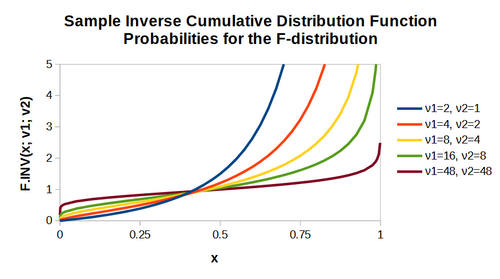Documentation/Calc Functions/F.INV
TDF LibreOffice Document Liberation Project Community Blogs Weblate Nextcloud Redmine Ask LibreOffice Donate
Function name:
F.INV
Category:
Statistical Analysis
Summary:
Calculates the inverse of a probability value from the cumulative distribution function for the F-distribution with a given number of degrees of freedom.
F-distributions (named in recognition of Sir Ronald Fisher) are a family of continuous probability distributions on the interval [0, +∞) that often arise in the statistical analysis of variance. The F-distribution has two characteristic parameters, known as the degrees of freedom for the numerator and the degrees of freedom for the denominator and these determine the shape of the distribution.
F.INV is the inverse of F.DIST, so that for valid arguments [math]\displaystyle{ \text{F.INV}(\text{F.DIST}(x;\:ν1;\:ν2;\:TRUE);\:ν1;\:ν2)~=~x }[/math].
Syntax:
F.INV(Number; Degrees freedom 1; Degrees freedom 2)
Returns:
Returns a non-negative real number, which is the inverse of the given probability value from the cumulative distribution function for the given F-distribution.
Arguments:
Number is a real number in the range (0, 1], or a reference to a cell containing that number, which is a probability in the cumulative distribution function of the F-distribution.
Degrees freedom 1 is a positive integer, or a reference to a cell containing that number, which is the degrees of freedom for the numerator of the F-distribution.
Degrees freedom 2 is a positive integer, or a reference to a cell containing that number, which is the degrees of freedom for the denominator of the F-distribution.
- If any of Number, Degrees freedom 1, or Degrees freedom 2 is non-numeric, then F.INV reports a #VALUE! error.
- If Number is less than or equal to 0.0, or greater than 1.0, then F.INV reports an invalid argument error (Err:502).
- If either Degrees freedom 1 or Degrees freedom 2 is less than 1.0, then F.INV reports an invalid argument error (Err:502).
- If either Degrees freedom 1 or Degrees freedom 2 is greater than or equal to [math]\displaystyle{ 1.0 \times 10^{10} }[/math], then F.INV reports an invalid argument error (Err:502).
- If either Degrees freedom 1 or Degrees freedom 2 is a non-integer value, then F.INV truncates it to an integer value.
- If the function’s iterative algorithm does not converge for the given arguments, then F.INV reports a calculation does not converge error (Err:523). An example is the formula
=F.INV(1; 2; 2).
Additional details:
- Calc's F.INV function implements the requirements specified for the FINV function in Section 6.18.24 of ODF 1.2.
- Calc's FINV function implements the requirements specified for the LEGACY.FINV function in Section 6.18.25 of ODF 1.2. Therefore, F.INV and FINV are not interchangeable.
- F.INV utilizes an iterative algorithm to determine the inverse of the specified cumulative distribution function probability.
- The following figure shows inverse cumulative distribution function probability plots for five sample F-distributions.
- The name space for F.INV is
COM.MICROSOFT.F.INV. - For more information about F-distributions, visit Wikipedia's F-distribution page.
Examples:
| Formula | Description | Returns |
|---|---|---|
| =F.INV(A1; A2; A3) where cells A1:A3 contain the values 0.5, 5, and 10 respectively. | The function calculates the inverse of the given value from the cumulative distribution function for the specified F-distribution. Note that the formula =F.INV(0.5; 5.9; 10.95) returns the same result because the non-integer degrees of freedom values are truncated. |
0.931933160851048 |
| =F.INV(0.385660356254188; 8; 12) | The function calculates the inverse of the given value from the cumulative distribution function for the specified F-distribution. Note that the formula =F.DIST(0.8; 8; 12) returns 0.385660356254188. |
0.8 |
Related LibreOffice functions:
ODF standard:
Related (or similar) Excel functions:
F.INV since v.2010.
